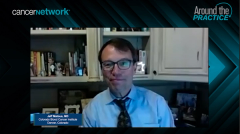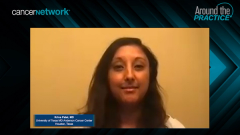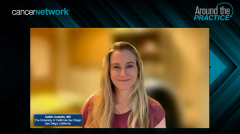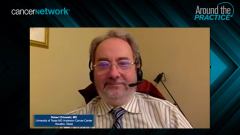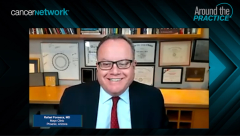
Treatment Duration and Response to Induction Therapy in Transplant-Eligible NDMM
Experts explain how to determine treatment duration and a successful response to induction therapy for transplant-eligible multiple myeloma.
Episodes in this series

Rafael Fonseca, MD: Let me follow up with a couple more questions, Dr Orlowski. What do you consider a successful treatment response for patients who are transplant-eligible before the transplant? Expanding a little on what we’re discussing, if you have great responses, if you have MRD [minimal residual disease] at 10-6, do you still think there’s an incremental benefit of proceeding with stem cell transplant?
Robert Orlowski, MD: Great question. In the past, we were happy with a partial remission before moving on to transplant. Now the goal should be at least a VGPR [very good partial response], which means at least a 90% reduction, and preferably that a CR [complete response] is achieved. It depends on how well patients are tolerating therapy, because you don’t want to have too many cumulative toxicities where they may not be eligible for transplant. Your question about MRD is a great one. My practice is that for standard-risk patients, if they’re able to achieve a complete remission and MRD negativity, especially at 10-6, I give them the option to harvest and hold, and go to maintenance. Whereas if they don’t achieve that, then I tell them, “OK, let’s go to transplant.” For patients with high-risk molecular disease, transplant is still important, even if you’re MRD negative.
Rafael Fonseca, MD: Thank you. Dr Matous, you had a point you wanted to make.
Jeff Matous, MD: I have a couple of points following up on Dr Orlowski’s points. One is that in myeloma, time and time again we’ve learned that the rich get richer. When you apply the things that work really well for high-risk disease to standard-risk patients, they benefit even more. That has been my experience. Then with respect to MRD, we track it a lot. I’m not using it for decision-making in my own practice. In our own group, we’re not using it for decision-making.
Rafael Fonseca, MD: Thank you. Let me go to Dr Patel. You alluded to this, that it’s critically important for the design of the MASTER clinical trial that if you have 2 consecutive MRD negatives, you can stop therapy. How do you use that to determine the treatment duration in your clinical practice? Does response matter? Dr Orlowski was talking about this. What are your thoughts in that regard?
Krina Patel, MD: I treat standard-risk and high-risk patients differently. It goes back to the opposite of what you were asking about, using daratumumab in maintenance if you haven’t had daratumumab up front. With daratumumab-lenalidomide maintenance, if you’ve already had daratumumab up front, should you continue? In the GRIFFIN trial, there was no randomization, so should those standard-risk patients get a quadruplet regimen and then get daratumumab-lenalidomide? In the CASSIOPEIA data, we didn’t necessarily see that in the randomized patients, that if they got daratumumab at all, they still did well. It didn’t help by doing it longer.
That toxicity question comes in there. For standard-risk patients, until we have more data, lenalidomide maintenance might be enough. However, a lot of my patients come in asking if they can stop therapy. That’s the big [question]. That’s where we come in at 2 to 3 years after maintenance and they ask, “Can I stop therapy?” For most of my patients, if they’re doing well on it and not having toxicity or financial toxicity, we continue. We might decrease the dose if they’re having major diarrhea or other issues, but we try to continue. I have some patients who at 3 or 4 years say, “I really want to stop.” We check MRD. We don’t say yes or no based on that, but we have it, so we have a record of what happened. Then they decide to stop and we keep a close eye on them.
My high-risk patients are very different. Even if they’re MRD negative, I’m still continuing maintenance. Usually I’m doing a doublet or triplet for at least a couple of years, depending on what high-risk features they have. Then we might go to a single agent after a few years and continue to watch them. But for the most part, we want continued pressure for those patients.
Rafael Fonseca, MD: Dr Patel, those are all excellent points. You raised more questions that you were able to answer with your response. That’s where we are in the field of multiple myeloma. Speaking of controversies, Dr Costello, when you have a patient who’s transplant-eligible and they have finished transplant, what are your thoughts on consolidation and maintenance? Let’s add another layer and say that you have a high-risk patient with MRD positivity post-transplant. Do we cross our fingers and put them on lenalidomide? What do we do?
Caitlin Costello, MD: You saved all the hard ones for me? Thanks. In general, when we’re talking about maintenance strategies, like Dr Patel, I try to stratify my treatment accordingly. I’m not very comfortable keeping high-risk patients on single-agent maintenance. Historically, we’ve done doublet maintenance with a proteasome inhibitor and an IMiD [immunomodulatory imide drug], for example. But the proteasome inhibitor can sometimes be hard to continue for the long run, and a CD38 monoclonal antibody is a nice partner with lenalidomide. We’ve seen that with the GRIFFIN and MAIA trials. It’s well tolerated. Sometimes the lenalidomide is harder than the daratumumab. My approach has been doublet maintenance for high-risk patients, and I’ve moving toward using the monoclonal antibody instead of proteasome inhibitors for high risk. For standard risk, I’m comfortable leaving people on single-agent lenalidomide.
Rafael Fonseca, MD: Thank you. Those are excellent points. We naturally think of maintenance with oral drugs, but sometimes the burden can be higher with an oral drug than with an injectable. That’s a legitimate question. If the patient was treated with a MAIA-like regimen—we’re going to cover that in our next section—maybe they’re going to have an easier time, projecting a longer duration of treatment, with an antibody. Thank you all very much for your comments and important insights into what we saw at ASH [American Society of Hematology annual meeting]. This concludes our section for transplant-eligible patients, and we’ll move on to transplant-ineligible patients.
Transcript edited for clarity.
Newsletter
Stay up to date on recent advances in the multidisciplinary approach to cancer.


